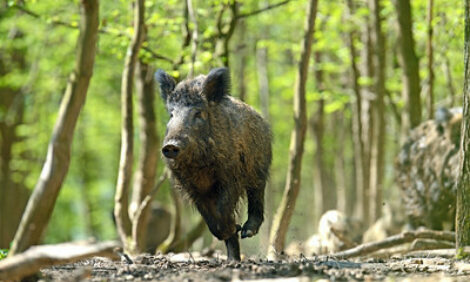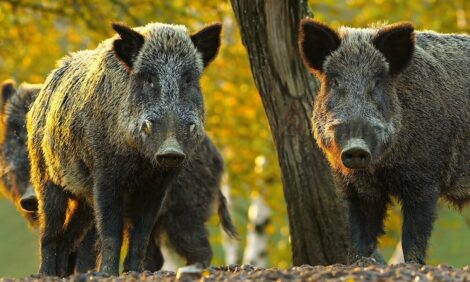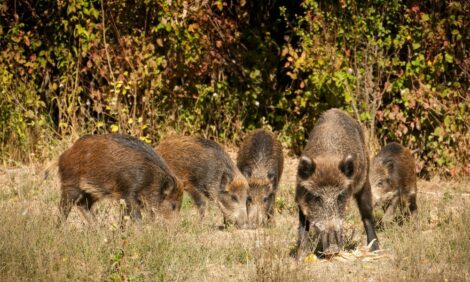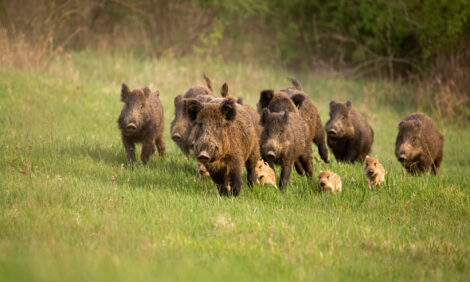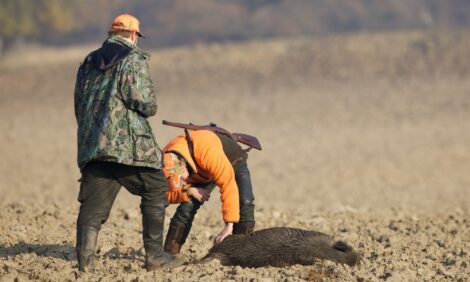



African swine fever in wild boar: data accompanying samples
Learn more about what kind of data to collect so resarchers can learn more about the epidemiology of ASF in wild boar populationsEditor's note: the following is an excerpt from African swine fever in wild boar populations - ecology and biosecurity. It was created by the FAO, WOAH and European Commission. Additional content from the booklet will be shared as an article series.
Vittorio Guberti, Sergei Khomenko and Marius Masiulis
The quality and standardization of the data accompanying samples are relevant since they enable a better understanding of the epidemiology of ASF in wild boar populations. High quality data allow appropriate comparisons to be made among areas and countries, as well as an assessment of the efficiency of the applied control measures. This chapter describes the main data to be collected and how these can be harmonized when obtained from different sources.
The aim of data collection is to improve understanding of animal diseases and the capacity to control and eradicate them. Data collection and analyses are an essential part of any animal disease surveillance programme, acting as a useful tool to measure the efficacy of control and eradication strategies, and eventually to highlight weak points.
In such a framework, a standardized data-collection protocol would benefit any analyses and decision-making. Standardized data would also enable a better understanding of how infected populations behave when ASF is present, along with the development of management strategies for the disease. Although standardized data collection may be an added workload for both hunters and veterinary services, unstandardized methods reduce data reliability and prevent comparability among infected countries.
Figure 23 shows a possible data-collection form with the essential data to be collected. In addition to the essential data, it is important to include the latitude and longitude of the spot where the animal was shot or found dead. Geographic data are relevant when studying the spatial and temporal evolution of the infection. Latitude and longitude are easy to register using a basic smartphone. In affected hunting grounds, hunting towers could be georeferenced and thus used as a proxy for the spot of interest. Specialized mobile applications can be a very helpful solution to facilitate the reporting process for hunters in terms of sample collections from hunter-harvested animals or carcass findings.
STANDARDIZED AGE CLASSES
At present, wild boar carcasses or hunted wild boar are aged using several methods that are highly affected by observer judgment and the individual variability of wild boar. Estimating the age of a wild boar by its weight or colour increases the unreliability of the reporting system, as such methods are not objective or standardized.
Teeth eruption is the most robust age estimator for any wild boar population. The main aim is to distinguish the age class and not the specific age of an individual. Due to high hunting pressure, the average lifespan of wild boar belonging to hunted populations is very low (about two years). In a typical population of hunted wild boar, around 50 percent are younger than 2 years, with the 50 percent older than 2 years rarely being older than 4 years. Due to the negligible number of older animals it is not necessary to determine their age using more complex methods, such as cementum annuli counts. According to the simplest application of the tooth eruption method, four age classes can be defined:
- no definitive molars present;
- one definitive molar present;
- two definitive molars present;
- three definitive molars present.
Definitive molars are easily counted in any field condition and in animal, as the approach does not need technical tools. This method gives standardized age classes that are easily comparable in the same population, among different populations and in different years and seasons.
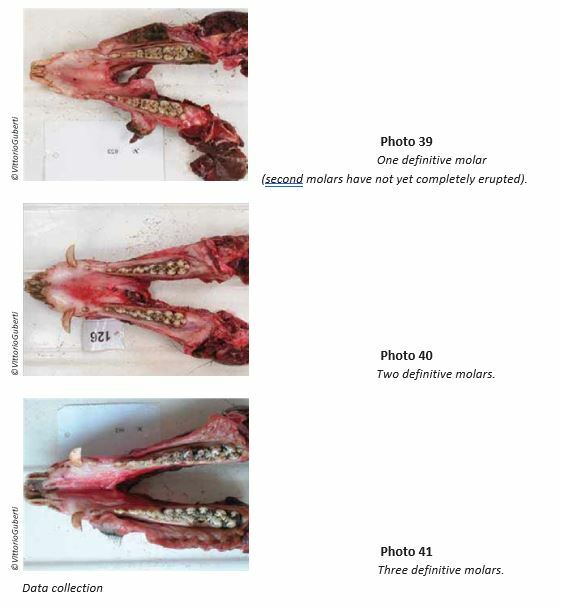
Fecundity
Fecundity could be defined as the percentage of pregnant females in a specific population. Fecundity data should be collected according to the age class category of the females to follow the reproductive performances of the infected population. Increased hunting could enhance the early recruitment of young females (< 1 year old) in the reproductive population, thus limiting the efficiency of this population management strategy. Suggested ASF control measures include the selective hunting of adult females in areas where it is possible to collect fecundity data. When dressing animals, the uterus can be opened to check for the presence of a fetus. Pregnancy is easier to observe at the end of the winter months when the delivery season is approaching and fetuses are visible.
Fertility
Fertility can be defined as the average number of fetuses or piglets for fecund females. Counting the number of fetuses in any shot pregnant female is extremely simple and can be easily done during dressing. During wild boar observation, the sight of each sow and the number of accompanying piglets (striped only) should be recorded and made available as raw data at the end of the main hunting season. Age-related fecundity and fertility data give an indication of the actual reproductive capacity of the involved wild boar population and thus enable its future trends to be predicted. These data also indicate shifts in the first age of reproduction or an increase in the average fertility, offering a better understanding of resilience to ASF. Ultimately, these data can be used to assess the effectiveness of the wild boar population management strategy being implemented.
Standardized Dating Of Carcasses (Rate Of Carcass Decomposition)
The role of carcasses in the epidemiology of ASF in wild boar has been previously highlighted. Currently, the date of carcass finding is set as the date of the infection, despite the fact that carcasses could be very old. This method can lead to imprecision in the dating of the infection and a wrong epidemiological assessment of the situation. Temperature, humidity, sunlight and the presence of scavengers (both invertebrate and vertebrate) can accelerate or reduce the time of carcass decomposition. If the decomposition status of animals is recorded in a standardized way and is coupled with the date of finding, it would be possible to avoid significant discrepancies in the dating of the infection, especially in infected areas and when carcass searches are planned and organized rather than an opportunistic activity. A simple designation of three decomposition categories could be included in the data-collection form when a carcass is found.
A standardized approach for reliable carcass dating should be included in the training of hunters in ASF-infected areas and hunting grounds, but such a defined procedure is yet to be developed. One obstacle to this is the seasonal variability in the rate and nature of the decomposition process itself. In summer months, the biological decay of carcasses is rather quick, with scavenging insects and their larvae facilitating the process. In winter months, vertebrate scavengers, whose species composition and activity may also vary among places and times, mainly destroy carcasses. As a result, carcasses with very different ages can be at the same stage of decomposition when found. In complicated cases, exclusively specific analyses (an entomological forensic approach) could help to precisely determine age. In general, in areas persistently endemic for ASF carcasses, the process of dating can be strongly compromised.
Doubtful carcasses (which are particularly common in early spring) should therefore be identified as “uncertain date” to enable their exclusion from analyses in the future.
TABLE 7 Characteristics of wild boar carcasses at various stages of decomposition
|
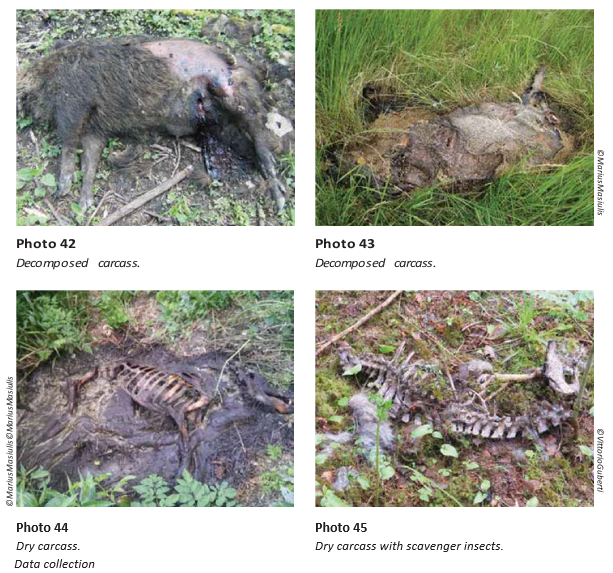
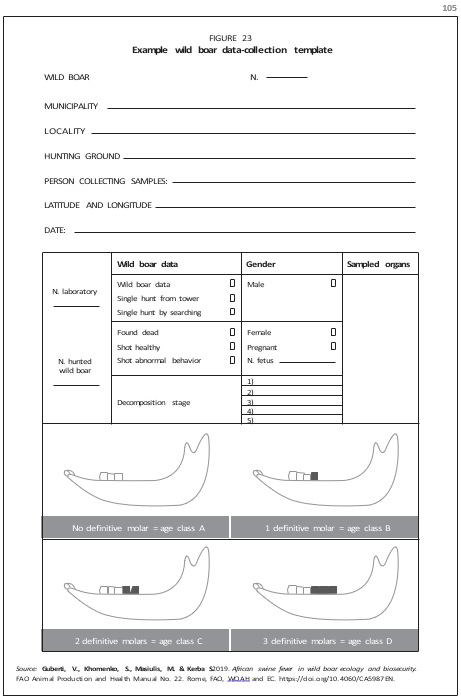
Key messages
- Each hunted wild boar or carcass found dead must be individually sampled and accompanied by a specific set of data.
- The age of the animal should be determined by teeth eruption only.
- Pregnancy and the number of fetuses must be carefully recorded; the data will enable a better understanding of the evolution of the wild boar population dynamic in affected areas.
- The decomposition stage of carcasses must be identified to help approximate the date of death of the infected individual.
Guberti, V., Khomenko, S., Masiulis, M. & Kerba S. 2022. Chapter 4. African swine fever in wild boar – Ecology and biosecurity. Second edition. FAO Animal Production and Health Manual No. 28. Rome, FAO, World Organisation for Animal Health and European Commission. https://doi.org/10.4060/cc0785







